Qlima S 2234 Split Unit Air Conditioner
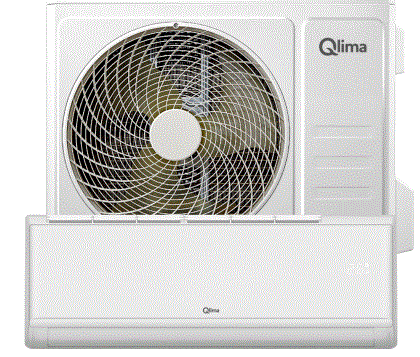
Product Specifications
- Model Numbers: S(C) 2226, S(C) 2234, S(C) 2251
- Temperature Range: 17°C to 32°C
- Power Supply: 4 GB
- Operating Modes: Sense, Cooling, Dry, Fan, Heating
- Fan Speeds: Automatic, High, Medium, Low
Dear Sir, Madam,
- Congratulations on the purchase of your air conditioner. You have acquired a high quality product that will provide you with many years of pleasure, provided you use it responsibly. Therefore, read this manual first for a maximum lifetime of you air conditioner.
- On behalf of the manufacturer we offer you a 24 month warranty against all material and manufacturing defects.
- We wish you coolness and comfort with your air conditioner.
Yours sincerely,
- PVG Holding B.V.
- Customer service department
SAFETY REGULATIONS
Install this device only when it complies with local/national legislation, regulation and standards. This product is intended to be used as an air conditioner in residential houses and is only suitable for use indoors in dry locations, in normal household conditions, like living rooms, kitchens, and garages. This device is suitable exclusively for earthed sockets, connection voltage 220-240 V ~/ 50 Hz.
IMPORTANT
- The device MUST be grounded. If the power supply is not grounded, you may not connect the device. The plug must always be readily accessible if the device is connected. Read this instruction manual carefully and follow the instructions.
- The air conditioner contains a refrigerant and can be classified as equipment under pressure. Therefore always call a qualified technician for the installation and maintenance of the air conditioner. The air conditioner has to be checked and serviced yearly by an authorised technician, otherwise the warranty looses its validity.
Check before connecting the device if:
- The supply voltage matches the mains voltage specified on the name plate;
- Socket and power supply are suited for the electrical voltage specified on the name plate;
- The plug of the power cord can be plugged into the socket;
- The device is positioned on a firm foundation.
Have the electrical installation checked by a qualified professional if you are not sure everything is done properly.
- This device is constructed according CE safety standards. You have to be careful, like with any electrical device.
- Never cover the air inlet and exhaust.
- Never let the device come into contact with chemicals.
- Never let the device come into contact with water, never spray water on it or immerge it in water. Switch off the device and disconnect the power supply if there is water running into the unit.
- Don’t put your hands, fingers or objects in the holes of the device.
- Never use the device with an extension cord. If there is no suited grounded socket available, have one installed by a qualified electrician.
- Repairs and/or maintenance should only be performed by an authorised technician or your regulated supplier. Follow the instructions for use and maintenance in this manual.
- Always disconnect from the mains if the device isn’t being used.
- Never turn the air conditioner on or off by inserting the plug in the socket or pulling it out. Only use the designated buttons on the air conditioner or the remote control.
- Never move the air conditioner when in service. Disconnect from the mains before opening the device.
- Always pull the plug out of the socket or disconnect the mains for cleaning or servicing the air conditioner.
- Never position gas burners, ovens of cooking devices in the airflow.
- Never touch buttons or the air conditioner with wet hands.
- The outdoor unit produces noise when the device is in service. This can be a violation of local statutory regulations. The user is responsible to check if the equipment fully complies with the local statutory legislations.
- This device is not intended to be used by persons (including children) with reduced physical, sensory or mental capacities, or lack of experience and knowledge, unless they are supervised and have been given instructions concerning the use of the device by a person responsible for their safety.
- Children must be supervised to make sure they don’t play with the device.
- Never stand directly in the airflow.
- Never drink the condensed water from the air conditioner
- Do not modify the product.
- If the power cord is damaged, it must be repaired by the manufacturer, its service agent or similarly qualified persons in order to avoid a hazard.
- This device can be used by children aged 8 and above and people with physical, sensory or intellectual disability and by people who don’t have experience with of knowledge about the device if they are being supervised or received instructions concerning the safe use of the device and are aware of the risks.
- Make sure children don’t play with the device.
- Cleaning and maintenance may not be performed by children without supervision.
- Do not use means to accelerate the defrosting process or to clean, other than those recommended by the manufacturer.
- Do not pierce or burn the appliance.
- The appliance shall be stored in a room without continuously operating sources (for example: open flames, an operating ignition gas appliance or an operating electric heater.)
ATTENTION!
- Never use the device if the power cord, plug, body or control panel is damaged.
- Failure to comply with the instructions could invalidate the warranty for this device.
Specific information regarding appliances with R290 / R32 refrigerant gas.
- Thoroughly read all of the warnings.
- When defrosting and cleaning the appliance, do not use any tools other than those recommended by the manufacturing company.
- The appliance must be placed in an area without any continuously sources of ignition (for example: open flames, gas or electrical appliances in operation).
- Do not puncture and do not burn.
- This appliance contains Y g (see rating label back of unit) of R290 / R32 refrigerant gas.
- R290 / R32 is a refrigerant gas that complies with the European directives on the environment. Do not puncture any part of the refrigerant circuit. Be aware the refrigerants may not contain an odour.
- If the appliance is installed, operated or stored in a nonventilated area, the room must be designed to prevent to the accumulation of refrigerant leaks resulting in a risk of fire or explosion due to ignition of the refrigerant caused by electric heaters, stoves, or other sources of ignition.
- The appliance must be stored in such a way as to prevent mechanical failure.
- Individuals who operate or work on the refrigerant circuit must have the appropriate certification issued by an accredited organization that ensures competence in handling refrigerants according to a specific evaluation recognized by associations in the industry.
- Repairs must be performed based on the recommendation from the manufacturing company.
- Maintenance and repairs that require the assistance of other qualified personnel must be performed under the supervision of an individual specified in the use of flammable refrigerants.
- Appliances shall be installed, operated and stored in a room with a floor area larger than 4 m2 The appliance shall be stored in a well-ventilated area where the room size corresponds to the room area as specified for operation.
INSTRUCTIONS FOR REPAIRING APPLIANCES CONTAINING R290 / R32
GENERAL INSTRUCTIONS
This instruction manual is intended for use by individuals possessing adequate backgrounds of electrical, electronic, refrigerant and mechanical experience.
Checks to the area
Prior to beginning work on systems containing flammable refrigerants, safety checks are necessary to ensure that the risk of ignition is minimized. For repair to the refrigerating system, the following precautions shall be complied with prior to conducting work on the system.
Work procedure
Work shall be undertaken under a controlled procedure so as to minimise the risk of a flammable gas or vapour being present while the work is being performed.
General work area
All maintenance staff and others working in the local area shall be instructed on the nature of work being carried out. Work in confined spaces shall be avoided. The area around the workspace shall be sectioned off. Ensure that the conditions within the area have been made safe by control of flammable material.
Checking for presence of refrigerant
The area shall be checked with an appropriate refrigerant detector prior to and during work, to ensure the technician is aware of potentially flammable atmospheres. Ensure that the leak detection equipment being used is suitable for use with flammable refrigerants, i.e. nonsparking, adequately sealed or intrinsically safe.
Presence of fire extinguisher
If any hot work is to be conducted on the refrigeration equipment or any associated parts, appropriate fire extinguishing equipment shall be available to hand. Have a dry powder or CO2 fire extinguisher adjacent to the charging area.
No ignition sources
No person carrying out work in relation to a refrigeration system which involves exposing any pipe work that contains or has contained flammable refrigerant shall use any sources of ignition in such a manner that it may lead to the risk of fire or explosion. All possible ignition sources, including cigarette smoking, should be kept sufficiently far away from the site of installation, repairing, removing and disposal, during which flammable refrigerant can possibly be released to the surrounding space. Prior to work taking place, the area around the equipment is to be surveyed to make sure that there are no flammable hazards or ignition risks. “No Smoking” signs shall be displayed.
Ventilated area
Ensure that the area is in the open or that it is adequately ventilated before breaking into the system or conducting any hot work. A degree of ventilation shall continue during the period that the work is carried out. The ventilation should safely disperse any released refrigerant and preferably expel it externally into the atmosphere.
Checks to the refrigeration equipment
Where electrical components are being changed, they shall be fit for the purpose and to the correct specification. At all times the manufacturer’s maintenance and service guidelines shall be followed. If in doubt consult the manufacturer’s technical department for assistance. The following checks shall be applied to installations using flammable refrigerants: – the charge size is in accordance with the room size within which the refrigerant containing parts are installed;
- the ventilation machinery and outlets are operating adequately and are not obstructed;
- if an indirect refrigerating circuit is being used, the secondary circuit shall be checked for the presence of refrigerant;
- marking to the equipment continues to be visible and legible. Markings and signs that are illegible shall be corrected;
- refrigeration pipe or components are installed in a position where they are unlikely to be exposed to any substance which may corrode refrigerant containing components, unless the components are constructed of materials which are inherently resistant to being corroded or are suitably protected against being so corroded.
Checks to electrical devices
Repair and maintenance to electrical components shall include initial safety checks and component inspection procedures. If a fault exists that could compromise safety, then no electrical supply shall be connected to the circuit until it is satisfactorily dealt with. If the fault cannot be corrected immediately but it is necessary to continue operation, an adequate temporary solution shall be used. This shall be reported to the owner of the equipment so all parties are advised. Initial safety checks shall include:
- that capacitors are discharged: this shall be done in a safe manner to avoid possibility of sparking;
- that there no live electrical components and wiring are exposed while charging, recovering or purging the system;
- that there is continuity of earth bonding.
REPAIRS TO SEALED COMPONENTS
- During repairs to sealed components, all electrical supplies shall be disconnected from the equipment being worked upon prior to any removal of sealed covers, etc. If it is absolutely necessary to have an electrical supply to equipment during servicing, then a permanently operating form of leak detection shall be located at the most critical point to warn of a potentially hazardous situation.
- Particular attention shall be paid to the following to ensure that by working on electrical components, the casing is not altered in such a way that the level of protection is affected. This shall include damage to cables, excessive number of connections, terminals not made to original specification, damage to seals, incorrect fitting of glands, etc.
Ensure that apparatus is mounted securely.
Ensure that seals or sealing materials have not degraded such that they no longer serve the purpose of preventing the ingress of flammable atmospheres. Replacement parts shall be in accordance with the manufacturer’s specifications.
NOTE The use of silicon sealant may inhibit the effectiveness of some types of leak detection equipment. Intrinsically safe components do not have to be isolated prior to working on them.
REPAIR TO INTRINSICALLY SAFE COMPONENTS
- Do not apply any permanent inductive or capacitance loads to the circuit without ensuring that this will not exceed the permissible voltage and current permitted tor the equipment in use.
- Intrinsically safe components are the only types that can be worked on while live in the presence of a flammable atmosphere. The test apparatus shall be at the correct rating.
- Replace components only with parts specified by the manufacturer. Other parts may result in the ignition of refrigerant in the atmosphere from a leak.
CABLING
Check that cabling will not be subject to wear, corrosion, excessive pressure, vibration, sharp edges or any other adverse environmental effects. The check shall also take into account the effects of aging or continua! vibration from sources such as compressors or fans.
DETECTION OF FLAMMABLE REFRIGERANTS
Under no circumstances shall potential sources of ignition be used in the searching for or detection of refrigerant leaks. A halide torch (or any other detector using a naked flame} shall not be used.
LEAK DETECTION METHODS
- The following leak detection methods are deemed acceptable for systems containing flammable refrigerants. Electronic leak detectors shall be used to detect flammable refrigerants, but the sensitivity may not be adequate, or may need recalibration. (Detection equipment shall be calibrated in a refrigerant-free area.) Ensure that the detector is not a potential source of ignition and is suitable for the refrigerant used. Leak detection equipment shall be set at a percentage of the LFL of the refrigerant and shall be calibrated to the refrigerant employed and the appropriate percentage of gas (25 % maximum} is confirmed.
- Leak detection fluids are suitable for use with most refrigerants but the use of detergents containing chlorine shall be avoided as the chlorine may react with the refrigerant and corrode the copper pipework.
- If a leak is suspected, all open flames shall be removed/extinguished.
- If a leakage of refrigerant is found which requires brazing, all of the refrigerant shall be recovered from the system, or isolated (by means of shut off valves} in a part of the system remote from the leak. Oxygen free nitrogen (OFN) shall then be purged through the system both before and during the brazing process.
REMOVAL AND EVACUATION
- When breaking into the refrigerant circuit to make repairs – or for any other purpose – conventional procedures shall be used. However, it is important that best practice is followed since flammability is a consideration. The following procedure shall be adhered to: remove refrigerant; purge the circuit with inert gas; evacuate; purge again with inert gas; open the circuit by cutting or brazing.
- The refrigerant charge shall be recovered into the correct recovery cylinders. The system shall be “flushed” with OFN to render the unit safe. This process may need to be repeated several times. Compressed air or oxygen shall not be used for this task. Flushing shall be achieved by breaking the vacuum in the system with OFN and continuing to fill until the working pressure is achieved, then venting to atmosphere, and finally pulling down to a vacuum. This process shall be repeated until no refrigerant is within the system.
- When the final OFN charge is used, the system shall be vented down to atmospheric pressure to enable work to take place. This operation is absolutely vital if brazing operations on the pipework are to take place. Ensure that the outlet tor the vacuum pump is not close to any ignition sources and !here is ventilation available.
CHARGING PROCEDURES
In addition to conventional charging procedures, the following requirements shall be followed. Ensure that contamination of different refrigerants does not occur when using charging equipment. Hoses or lines shall be as short as possible to minimise the amount of refrigerant contained in them. Cylinders shall be kept upright. Ensure that the refrigeration system is earthed prior to charging the system with refrigerant. Label the system when charging is complete (if not already). Extreme care shall be taken not to overfill the refrigeration system. Prior to recharging the system it shall be pressure tested with OFN. The system shall be leak tested on completion of charging but prior to commissioning. A follow up leak test shall be carried out prior to leaving the site.
DECOMMISSIONING
Before carrying out this procedure, it is essential that the technician is completely familiar with the equipment and all its detail. It is recommended good practice that all refrigerants are recovered safely. Prior to the task being carried out, an oil and refrigerant sample shall be taken in case analysis is required prior to re-use of reclaimed refrigerant. It is essential that 4 GB electrical power is available before the task is commenced.
- Become familiar with the equipment and its operation.
- Isolate system electrically.
- Before attempting the procedure ensure that: mechanical handling equipment is available, if required, for handling refrigerant cylinders;
- All personal protective equipment is available and being used correctly; the recovery process is supervised at all times by a competent person;
- recovery equipment and cylinders conform to the appropriate standards.
- Pump down refrigerant system, if possible.
- If a vacuum is not possible, make a manifold so that refrigerant can be removed from various parts of the system.
- Make sure that cylinder is situated on the scales before recovery takes place.
- Start the recovery machine and operate in accordance with manufacturer’s instructions.
- Do not overfill cylinders. (No more than 80 % volume liquid charge).
- Do not exceed the maximum working pressure of the cylinder, even temporarily.
- When the cylinders have been filled correctly and the process completed, make sure that the cylinders and the equipment are removed from site promptly and all isolation valves on the equipment are closed off.
- Recovered refrigerant shall not be charged into another refrigeration system unless it has been cleaned and checked.
LABELLING
Equipment shall be labelled stating that it has been de-commissioned and emptied of refrigerant. The label shall be dated and signed. Ensure that there are labels on the equipment stating the equipment contains flammable refrigerant.
RECOVERY
- When removing refrigerant from a system, either for servicing or decommissioning, ii is recommended good practice that all refrigerants are removed safely. When transferring refrigerant into cylinders, ensure that only appropriate refrigerant recovery cylinders are employed. Ensure that the correct number of cylinders for holding the total system charge are available. All cylinders to be used are designated for the recovered refrigerant and labelled for that refrigerant (i.e. special cylinders for the recovery of refrigerant). Cylinders shall be complete with pressure relief valve and associated shut-off valves in good working order. Empty recovery cylinders are evacuated and, if possible, cooled before recovery occurs.
- The recovery equipment shall be in good working order with a set of instructions concerning the equipment that is at hand and shall be suitable for the recovery of flammable refrigerants. In addition, a set of calibrated weighing scales shall be available and in good working order. Hoses shall be complete with leak-free disconnect couplings and in good condition. Before using the recovery machine, check that ii is in satisfactory working order, has been properly maintained and that any associated electrical components are sealed to prevent ignition in the event of a refrigerant release. Consult manufacturer if in doubt.
- The recovered refrigerant shall be returned to the refrigerant supplier in the correct recovery cylinder, and the relevant Waste Transfer Note arranged. Do not mix refrigerants in recovery units and especially not in cylinders.
- If compressors or compressor oils are to be removed, ensure that they have been evacuated to an acceptable level to make certain that flammable refrigerant does not remain within the lubricant. The evacuation process shall be carried out prior to returning the compressor to the suppliers. Only electric healing to the compressor body shall be employed to accelerate this process. When oil is drained from a system, ii shall be carried out
safely.
PARTS
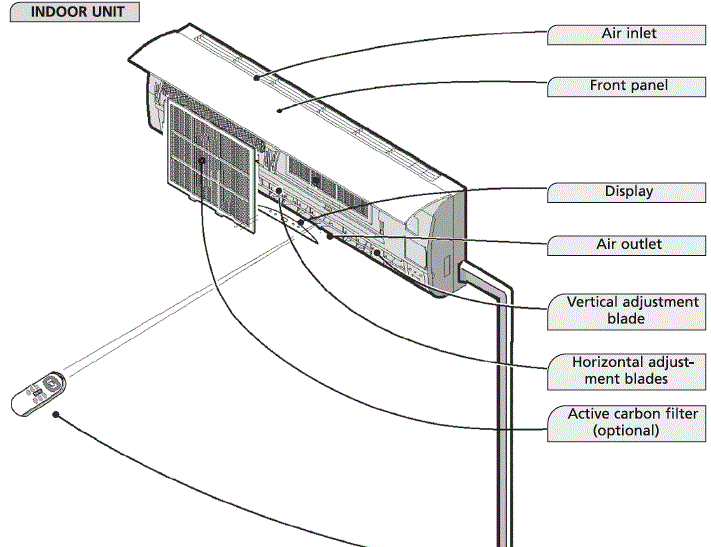
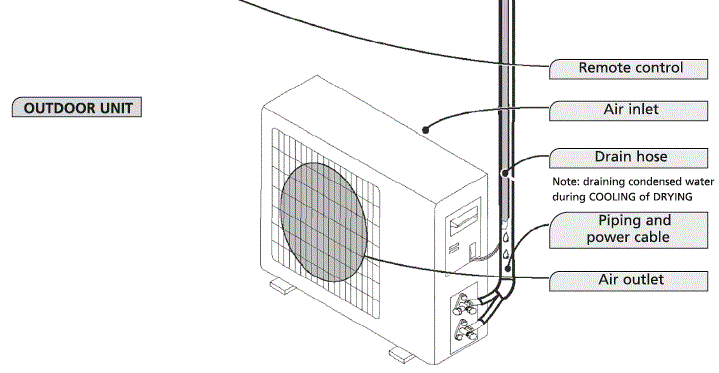
The illustrations in this manual are based on a standard model. The air conditioner you bought might be another model.
BEFORE USE
Before using the air conditioner you must check and set the following.
Setting remote control
- The remote control is NOT set by the manufacturer for the function only cooling or heating, you have to set these functions yourself.
- Every time the batteries of the remote control are replaced, the arrow “Heat” or “Cool” on the display of the remote control will flash.
- Depending on your type of air conditioner, you must set the remote control as follows:
- Press any button if the arrow in front of “Heat” flashes, the heat pump is set.
- Press any button if the arrow in front of “Cool” flashes, only cooling is set.
- If you don’t press a button within 10 seconds, the remote control will automatically be set on cooling.
OPERATION
Operation and display

- Temperature indication LED
Shows the set temperature - Indication LED Timer function
Shows the timer function is activated. - Indication LED sleep function
Shows the sleep function is activated.
Remote control
The remote control sends signals to the system.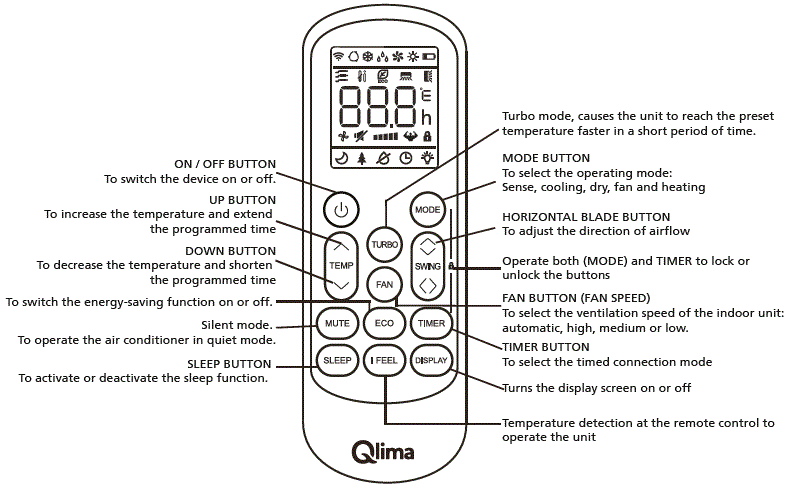
Note: Every mode and the relevant functions will be specified hereafter.
Placement of batteries
- Remove the battery cover in the direction of the arrow.
- Insert new batteries as shown (align the positive (+) and negative (-) symbols.
- Slide the battery cover back in position.
Note: use 2 LR03 AAA(I .5volt) batteries. DO not use rechargeable batteries. Replace batteries with batteries of the same type (see above) if the display becomes more blurred.
Storage of the remote control and tips for using
The remote control can be stored in a holder, mounted against the wall.
Using the remote control
- Point the remote control towards the receiver on the indoor unit of the air conditioner. This way, the air conditioner can be operated from a distance up to 7 meter.
- Please note that the batteries are not included
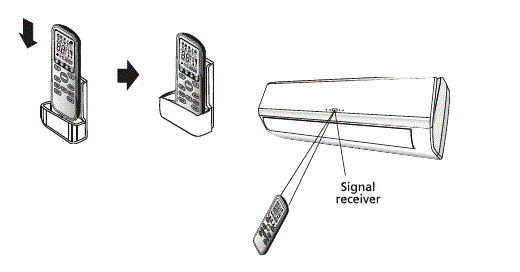
OPERATING INSTRUCTIONS
FEEL mode operating mode ![]()
The operating mode is selected automatically (HEATING, DRY, FAN, COOLING) depending on the room temperature at the time of selection.
With the remote control pointed towards the air conditioner.
- Turn on
Press the ON/OFF/RUN button. When the device receives a signal, the indication light RUNNING of the indoor unit lights up.
If the unit is not in the FEEL mode. - Select FEEL mode
Press the MODE button Switching from MODE to FEEL Operating mode and temperature will be set according the indoor temperature.
Operating mode and temperature will be set according the indoor temperature.
Indoor temperature Less than 20 cc
Operating mode Heating for ‘heat pump’ type
Fan for ‘cooling only’ type
Desired temperature 23cc
20 – 26cc DRY 13cc More than 26 cc COOLING 23cc Indoor temperature Operating mode Desired temperature
- Heating for Less than 20 ° c ‘heat pump’ type 23° c
- Fan for ‘cooling only’ type 20 – 26° C DRY 18° C
- More than 26 ° c COOLING 23° c
- Set temperature
Press the button or the
button or the  button.
button.
By pressing the button, the set value of the set temperature will be increased by 1°c. After the temperature is increased by 2°C, the indication light will remain unchanged. By pressing the button, the set value of the set temperature will be decreased by 1 °C.
button, the set value of the set temperature will be increased by 1°c. After the temperature is increased by 2°C, the indication light will remain unchanged. By pressing the button, the set value of the set temperature will be decreased by 1 °C.
After the temperature is decreased by 2°c, the indication light will remain unchanged. Note: It might occur that there is no air flow with the unit in service. When changing the mode the unit isn’t always in service right away.
Cooling mode (COOL) ![]() heating (HEAT) ,*
heating (HEAT) ,* ![]() and ventilate (FAN)
and ventilate (FAN) ![]()
With the remote control pointed towards the air conditioner.
- Press the power button. When the device receives a signal, the indication light “running” of the indoor unit lights up.
- Press the MODE button to select the desired mode, cooling, ventilating or heating.
- In the heating and cooling mode it is possible to set the desired temperature with the (J) and+ ® buttons and the desired fan speed, AUTO

 with the FAN button on the remote control.
with the FAN button on the remote control. - In the mode ventilate it is not possible to set the room temperature. The speed of the fan can be set with the FAN button to LOW, MID or HIGH.
If the fan is set to AUTO, the fan will automatically activate the most favourable fan speed. When the room temperature comes closer to the set temperature, the speed of the fan will decrease.
Features
Features of the HEATING mode
To heat
After the HEATING function is activated, the indoor unit will start blowing air after 2 – 5 minutes.
After heating
After the Heating function is stopped, the fan of the indoor unit will continue running for 2 – 5 minutes.
Defrost
During HEATING the device will defrost automatically for the best performance. This procedure normally takes 2 – 10 minutes. The fan will stop during defrosting. After defrosting the HEATING function will restart automatically.
Dehumidify mode ![]()
With the remote control pointed towards the air conditioner.
- Press the power button. When the device receives a signal, the indication light “running” of the indoor unit lights up.
- Press the mode button and select the DRY mode. The air conditioner will now dehumidify the room.
- When the room temperature reaches 18°C, the air conditioner will automatically stop dehumidifying. The air conditioner will restart automatically when the room temperature reaches 20 °C.
When activating dehumidifying, the fan speed will be automatically set to AUTO.
The desired room temperature can not be changed in de dry mode. This is automatically set to 18°C
TIMER mode ![]()
When you set the timer with the TIMER button when you leave, it will be comfortable when you return home. At night you can turn off the timer.
SET TIMER
The following procedure must be followed to turn on the air conditioner at the desired time (the remote control and the air conditioner are turned off):
- Press the Timer button.
- Choose the desired mode by pressing the Mode button.
- Choose the desired temperature by pressing the button (only possible if the ‘cool’ or ‘heat’ mode is selected).
- Choose the fan speed (low, medium or high) or the automatic mode (only possible if the Feel, Cool or Heat mode is selected) by pressing the Fan button
In the Dry mode the fan always runs on the Auto mode. - Choose Swing or No swing by pressing the Swing button.
- Press the Timer button (‘h’ flashes).
- Use the 78 button to select the period the air conditioner has to be turned on (between O and 10 you can set the time per half hour; between 10 and 24, you can set the time per hour).
- Press the Timer button (‘h” will stop flashing) and the set time will appear on the display.
- Press on the Timer button again to delete de selected data from the memory.
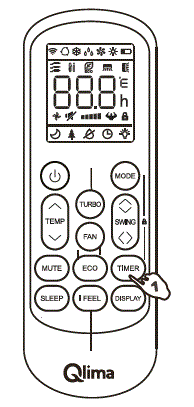
Note: When no buttons have been pushed during setting the timer function, the remote control will automatically turn off after 10 seconds.
The following procedure must be followed to turn off the air conditioner at the desired time (the remote control and the air conditioner are turned off):
- Press the Timer button.
- Use the 78 button to select the period the air conditioner has to be turned off (between O and 10 you can set the time per half hour; between 10 and 24, you can set the time per hour).
- Press the Timer button (‘h” will stop flashing) and the set time will appear on the display.
- Press on the Timer button again to delete de selected data from the memory.
- Note: When no buttons have been pushed during setting the timer function, the remote control will automatically turn off after 10 seconds.
- Note: if ‘h’ is flashing and you press the ON/OFF/RUN button once, the set temperature will appear on the display. You can now change the temperature with the button. If you press the Timer button, the time will appear again and can be changed at this moment*. If you press the Timer button again, all data will be saved and the remaining time (the air conditioner will be turned on) will appear on the display.
- When you press the ON/OFF/RUN button in stead of the Timer button, the remote control will be turned off.
- Press the Timer function to check the settings on the display.
SWING function
Carry out the operations below when the air conditioner is in service.
- Press the SWING button to activate the swing function. The vertical blades will now move up and down to distribute the air to the room better in the vertical direction.
- Press the SWING button again, the vertical blade will stop at the position during the moment the SWING button is pressed.
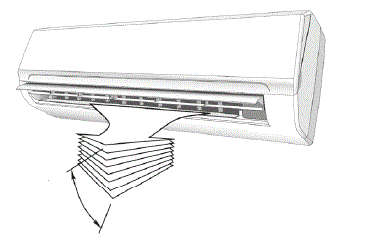
Horizontal air distribution
The horizontal air flow can be changed manually by adapting the horizontal blades with the levers, see picture. 
SLEEP mode![]()
Carry out the operations below when the air conditioner is in service.
- Press the SLEEP button to activate the sleep function.
- Press the SLEEP button or the MODE button to select another mode and turn off the SLEEP mode.
In SLEEP mode the air conditioner will control the room temperature as follows:
- In the cooling mode the set temperature will be increased automatically by 1 °C after 1 hour. After two hours, the set temperature will be increased again by 1 °C.
- In the heating mode the set temperature will be decreased automatically by 1 °C after 1 hour. After two hours, the set temperature will be decreased again by 1 °C.
- In the FEEL mode the air conditioner will set the temperature according point 1 or 2, depending on whether the air conditioner must cool or heat the room.
- In the SLEEP mode, the air conditioner will be turned off automatically after 10 hours.
- The SLEEP mode can only be used when the FEEL, cooling or heating modus is selected.
- TURBO function

Press TURBO button to make the unit work extra hard. In COOUHEAT/FAN mode, when you select TURBO feature, it will use the highest fan setting and use the preset temperature of 16°C in COOL mode and 31 °C in HEAT mode. Press it again to inactivate the pre-setting status. - Mute mode

Press Mute button to activate mute mode, the unit will blow the lowest fan setting and the compressor works at lowest capacity. This may result in insufficient cooling and heating capacity. Press it again to cancel mute mode. - I FEEL mode

Press I Feel button to enable the remote control to measure the temperature at its current location and send this signal to the air conditioner to enable the air conditioner to optimize the temperature around you and ensure maximum comfort. Press it again to cancel the I FEEL mode. - ECO mode

Press the ECO button to enable the unit to work in an economic situation like adjusting the compressor frequency and fan speed. Press it again to cancel the ECO mode. - Lock mode

Press Mode and Timer together to lock or unlock the keyboard, when locked, all buttons can’t be operated until they are unlocked. The remote controller screen shows “LO”.
MAINTENANCE
Cleaning the front panel
- Turn off the device and pull the plug out of the socket.
- Grab the front panel at position “a” and pull it towards you.
- Clean with a soft, dry cloth.
Use lukewarm water (max. 30° C) to remove persistent dirt. - Never use volatile substances like gasoline, or an abrasive to remove dirt.
- Never spray water on the indoor unit.
Danger! Electrical shock! - Replace the front panel and close it by pressing down position “b”.

Cleaning the air filter
The air filter must be cleaned regularly.
Do this as follows:
- Turn off the device completely.
- Open the front panel.
- Grab the lever and pull the filter out.
- Clean the air filter and insert it again.
Clean a very dirty filter in lukewarm water with detergent. Let the filter completely dry at a spot with- out direct sunlight after cleaning. - Close the front panel.
When the air conditioner is being used in a very dusty environment, it has to be cleaned every two weeks.
SPECIFICATIONS
| Model | S 2226 outdoor unit | S 2226 indoor unit | S 2234 outdoor unit | S 2234 indoor unit | S 2251 outdoor unit | S 2251 indoor unit | |
| Air conditioner type | Wall mode air conditioner | Wall mode air conditioner | Wall model air conditioner | Wall mode air conditioner | Wall model air conditioner | Wall mode air conditioner | |
| Cooling capacity* | w | 2630(940-3400) | 2630 | 3400(1000-3770) | 3400 | 5100(1250-5910) | 5100 |
| EE rating cooling* | A++ | A++ | A++ | A++ | A++ | A++ | |
| SEER’ | 6.1 | 6.1 | 6.1 | 6.1 | 6.1 | 6.1 | |
| Heating capacity• | w | 2750(940-3500) | 2750 | 3430(1000-3810) | 3430 | 5100(1250-6070) | 5100 |
| EE rating heating• | A+ | A+ | A+ | A+ | A+ | A+ | |
| SCOP’ | 4.0 | 4.0 | 4.0 | 4.0 | 4.0 | 4.0 | |
| Dehumidifying capacity •• / ••• | I/ 24 h | 24.0 | 28.8 | 36.0 | |||
| Power consumption cooling | kW | 0.80 | 0.035 | 1.05 | 0.035 | 1.57 | 0.052 |
| Power consumption heating | kW | 0.73 | 0.035 | 0.92 | 0.035 | 1.37 | 0.052 |
| Yearly power consumption cooling/ heating | kWh | 149/840 | 195/840 | 293/1330 | |||
| Power input | V/Hz/Ph | 220-240-/50/1 | 220-240-/50/1 | 220-240-/50/1 | 220-240-/50/1 | 220-240-/50/1 | 220-240-/50/1 |
| Max. current | A | 9.0 | 0.2 | 10.0 | 0.2 | 13.0 | 0.34 |
| Airflow** | m3/h | 1900 | 550 | 1900 | 550 | 2600 | 800 |
| For rooms from – to •• | m3 | 60-85 | 80-100 | 140-185 | |||
| Suited for regions | A | A | A | ||||
| Compressor type | Rotary | Rotary | Rotary | ||||
| Fan speeds | 3 | 3 | 3 | ||||
| Thermostatic range | ‘C | 16-31 | 16-31 | 16-31 | 16-31 | 16-31 | 16-31 |
| Manual/ mechanical/ electronic control | Electronic remote control | Electronic remote control | Electronic remote control | ||||
| Remote control Yes/ No | Yes | Yes | Yes | ||||
| Air filter type(s) | Mesh | Mesh | Mesh | ||||
| Refrigerant type/ filling | C/g | R32/570 | R32/570 | R32/1000 | |||
| Refrigerant GWP | 675 | 675 | 675 | ||||
| CO2 equivalent | tonnes. | 0.385 | 0.385 | 0.675 | |||
| Diameter refrigerant piping Fluid – Gas | mm | 1/4″/3/8″ | 1/4″/3/8″ | 1/4″/3/8″ | |||
| Dimensions indoor unit (WxHxD) | mm | 777x250x201 | 777x250x201 | 910x294x206 | |||
| Dimensions outdoor unit (WxHxD) | mm | 777x498x290 | 777x498x290 | 853x602x349 | |||
| Net weight indoor unit | kg | 8.0 | 8.0 | 10.0 | |||
| Net weight outdoor unit | kg | 24 | 24 | 35 | |||
| Gross weight indoor unit | kg | 10.5 | 10.5 | 13.0 | |||
| Gross weight outdoor unit | kg | 26 | 26 | 38 | |||
| Sound level indoor unir0 | dB(A) | 52 | 52 | 53 | |||
| Sound level outdoor unit”.. | dB(A) | 62 | 62 | 65 | |||
| Sound pressure level indoor unit (low)**** | dB | 22 | 22 | 27 | |||
| Protection indoor unit | IP | IPXO | IPXO | IPXO | |||
| Protection outdoor unit | IP | IPX4 | IPX4 | IPX4 | |||
| Refrigerant R32 | Room area | Above 4m2 | Above 4m2 | Above 4m2 | Above 4m2 | Above 4m2 | Above 4m2 |
OPERATING TEMPERATURES
Cooling, heating and / or dehumidifying is possible at the following inside or outside temperature.

TROUBLESHOOTING
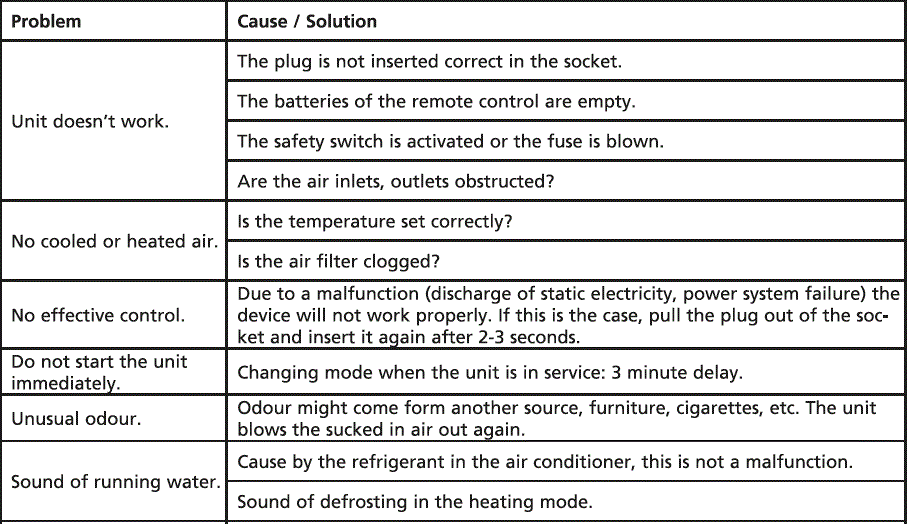

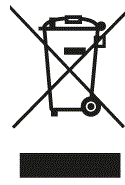 WASTE DISPOSAL
WASTE DISPOSAL
Don’t dispose electrical devices with household waste; deliver it to a designated collection point. Contact the local authorities for information about places for disposal of electrical devices. When electrical devices are dumped at landfills or dumps. hazardous substances can leak into the groundwater and get into the food chain, with all consequences for the health of the local population. When replacing old devices it is the legal responsibility of the supplication to collect the Old device for disposal, Don’t throw batteries into fire, They can explode or leak hazardous fluids. When you replace or dispose the remote control. remove the batteries and dispose them according the legislation applicable. They are harmful to the environment.
Environmental information: This device contains fluorinated greenhouse gases, as stated in the Kyoto pro- tool, The equipment may be repaired or dismantled only by professional, trained personal, This device contains refrigerant R32, the amount is indicated in the table above. Don’t let R32 escape into the atmosphere: R32 is a fluorinated greenhouse gas with greenhouse gas effect (GWP) 675.
Internet:
In order to provide a better service, you can download the latest version Of the user, installation, or service manual at www.qlima.com.
- * EN 14511/EN 14825
- ** Use indicative
- *** Remove moisture at 27°C, 60% RL
- **** EN 12108
Distributed in Europe by PVG Holding B.V.
If you need information or if you have a problem, please visit the our website (www.qlima.com) or contact our sales support (T: +31 412 694 694).
- PVG Holding BV –
- Kanaalstraat 12 C – 5347 KM Oss
- the Netherlands
- P.O. Box 96 – 5340 AB Oss –
- the Netherlands
Frequently Asked Questions
Are batteries included with the product?
No, please note that the batteries are not included with the product.
Documents / Resources
 |
Qlima S 2234 Split Unit Air Conditioner [pdf] Instruction Manual S 2234, S 3925, S 3932, S 3948, S 2226, S 2251, S 2234 Split Unit Air Conditioner, S 2234, Split Unit Air Conditioner, Unit Air Conditioner, Air Conditioner |
